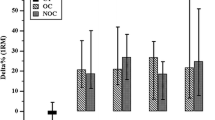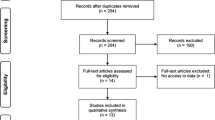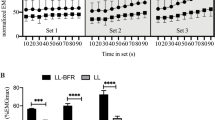Abstract
Purpose
We compared the effects of different protocols of blood-flow restriction training (BFRT) with different occlusion pressures and/or exercise intensities on muscle mass and strength. We also compared BFRT protocols with conventional high-intensity resistance training (RT).
Methods
Twenty-six subjects had each leg allocated to two of five protocols. BFRT protocols were performed at either 20 or 40 % 1-RM with either 40 or 80 % occlusion pressure: BFRT20/40, BFRT20/80, BFRT40/40, and BFRT40/80. Conventional RT was performed at 80 % 1-RM (RT80) without blood-flow restriction. Maximum dynamic strength (1-RM) and quadriceps cross-sectional area (CSA) were assessed at baseline and after 12 weeks.
Results
Regarding muscle mass, increasing occlusion pressure was effective only at very low intensity (BFRT20/40 0.78 % vs. BFRT20/80 3.22 %). No additional increase was observed at higher intensities (BFRT40/40 4.45 % vs. BFRT40/80 5.30 %), with no difference between the latter protocols and RT80 (5.90 %). Exercise intensity played a role in CSA when comparing groups with similar occlusion pressure. Muscle strength was similarly increased among BFRT groups (~12.10 %) but to a lesser extent than RT80 (21.60 %).
Conclusion
In conclusion, BFRT protocols benefit from higher occlusion pressure (80 %) when exercising at very low intensities. Conversely, occlusion pressure seems secondary to exercise intensity in more intense (40 % 1-RM) BFRT protocols. Finally, when considering muscle strength, BFRT protocols seem less effective than high-intensity RT.




Similar content being viewed by others
Abbreviations
- 1-RM:
-
One-repetition maximum dynamic strength
- BFRT:
-
Blood-flow restriction training
- CSA:
-
Cross-sectional area
- ES:
-
Effect size
- ESCLdiff :
-
Confidence intervals of the effect size
- MRI:
-
Magnetic resonance imaging
- RT:
-
Resistance training
References
Abe T, Loenneke JP, Fahs CA, Rossow LM, Thiebaud RS, Bemben MG (2012) Exercise intensity and muscle hypertrophy in blood flow-restricted limbs and non-restricted muscles: a brief review. Clin Physiol Funct Imaging 32:247–252
Barcelos LC, Nunes PR, de Souza LR, de Oliveira AA, Furlanetto R, Marocolo M, Orsatti FL (2015) Low-load resistance training promotes muscular adaptation regardless of vascular occlusion, load, or volume. Eur J Appl Physiol 115(7):1559–1568
Berg HE, Tedner B, Tesch PA (1993) Changes in lower limb muscle cross-sectional area and tissue fluid volume after transition from standing to supine. Acta Physiol Scand 148:379–385
Brown LE, Weir JP (2001) Procedures recommendation I: accurate assessment of muscular strength and power. J Exerc Physiol Online 4:1–21
Counts BR, Dankel SJ, Barnett BE, Kim D, Mouser JG, Allen KM, Thiebaud RS, Abe T, Bemben MG, Loenneke JP (2015) The influence of relative blood flow restriction pressure on muscle activation and muscle adaptation. Muscle Nerve [Epub ahead of print]
Gualano B, Ugrinowitsch C, Neves M, Jr., Lima FR, Pinto ALS, Laurentino G, Tricoli VA, Lancha AH, Jr., Roschel H (2010) Vascular occlusion training for inclusion body myositis: a novel therapeutic approach. J Vis Exp. doi:10.3791/1894
Karabulut M, Abe T, Sato Y, Bemben MG (2010) The effects of low-intensity resistance training with vascular restriction on leg muscle strength in older men. Eur J Appl Physiol 108:147–155
Kubo K, Komuro T, Ishiguro N, Tsunoda N, Sato Y, Ishii N, Kanehisa H, Fukunaga T (2006) Effects of low-load resistance training with vascular occlusion on the mechanical properties of muscle and tendon. J Appl Biomech 22:112–119
Laurentino G, Ugrinowitsch C, Aihara AY, Fernandes AR, Parcell AC, Ricard M, Tricoli V (2008) Effects of strength training and vascular occlusion. Int J Sports Med 29:664–667
Laurentino GC, Ugrinowitsch C, Roschel H, Aoki MS, Soares AG, Neves M Jr, Aihara AY, Fernandes Ada R, Tricoli V (2012) Strength training with blood flow restriction diminishes myostatin gene expression. Med Sci Sports Exerc 44:406–412
Loenneke JP, Fahs CA, Wilson JM, Bemben MG (2011) Blood flow restriction: the metabolite/volume threshold theory. Med Hypotheses 77:748–752
Loenneke JP, Fahs CA, Rossow LM, Sherk VD, Thiebaud RS, Abe T, Bemben DA, Bemben MG (2012a) Effects of cuff width on arterial occlusion: implications for blood flow restricted exercise. Eur J Appl Physiol 112:2903–2912
Loenneke JP, Wilson JM, Marin PJ, Zourdos MC, Bemben MG (2012b) Low intensity blood flow restriction training: a meta-analysis. Eur J Appl Physiol 112:1849–1859
Loenneke JP, Kim D, Fahs CA, Thiebaud RS, Abe T, Larson RD, Bemben DA, Bemben MG (2014a) Effects of exercise with and without different degrees of blood flow restriction on torque and muscle activation. Muscle Nerve 51(5):713–721
Loenneke JP, Thiebaud RS, Abe T, Bemben MG (2014b) Blood flow restriction pressure recommendations: the hormesis hypothesis. Med Hypotheses 82:623–626
Lowery RP, Joy JM, Loenneke JP, de Souza EO, Machado M, Dudeck JE, Wilson JM (2014) Practical blood flow restriction training increases muscle hypertrophy during a periodized resistance training programme. Clin Physiol Funct Imaging 34:317–321
Manini TM, Clark BC (2009) Blood flow restricted exercise and skeletal muscle health. Exerc Sport Sci Rev 37:78–85
McCall GE, Byrnes WC, Dickinson A, Pattany PM, Fleck SJ (1996) Muscle fiber hypertrophy, hyperplasia, and capillary density in college men after resistance training. J Appl Physiol 81:2004–2012
Mitchell CJ, Churchward-Venne TA, West DW, Burd NA, Breen L, Baker SK, Phillips SM (2012) Resistance exercise load does not determine training-mediated hypertrophic gains in young men. J Appl Physiol 113:71–77
Nakagawa S, Cuthill IC (2007) Effect size, confidence interval and statistical significance: a practical guide for biologists. Biol Rev Camb Philos Soc 82:591–605
Pincivero DM, Gandhi V, Timmons MK, Coelho AJ (2006) Quadriceps femoris electromyogram during concentric, isometric and eccentric phases of fatiguing dynamic knee extensions. J Biomech 39:246–254
Sadamoto T, Bonde-Petersen F, Suzuki Y (1983) Skeletal muscle tension, flow, pressure, and EMG during sustained isometric contractions in humans. Eur J Appl Physiol 51:395–408
Suga T, Okita K, Morita N, Yokota T, Hirabayashi K, Horiuchi M, Takada S, Takahashi T, Omokawa M, Kinugawa S, Tsutsui H (2009) Intramuscular metabolism during low-intensity resistance exercise with blood flow restriction. J Appl Physiol 106:1119–1124
Suga T, Okita K, Morita N, Yokota T, Hirabayashi K, Horiuchi M, Takada S, Omokawa M, Kinugawa S, Tsutsui H (2010) Dose effect on intramuscular metabolic stress during low-intensity resistance exercise with blood flow restriction. J Appl Physiol 108:1563–1567
Suga T, Okita K, Takada S, Omokawa M, Kadoguchi T, Yokota T, Hirabayashi K, Takahashi M, Morita N, Horiuchi M, Kinugawa S, Tsutsui H (2012) Effect of multiple set on intramuscular metabolic stress during low-intensity resistance exercise with blood flow restriction. Eur J Appl Physiol 112:3915–3920
Sugaya M, Yasuda T, Suga T, Okita K, Abe T (2011) Change in intramuscular inorganic phosphate during multiple sets of blood flow-restricted low-intensity exercise. Clin Physiol Funct Imaging 31:411–413
Takada S, Okita K, Suga T, Omokawa M, Kadoguchi T, Sato T, Takahashi M, Yokota T, Hirabayashi K, Morita N, Horiuchi M, Kinugawa S, Tsutsui H (2012) Low-intensity exercise can increase muscle mass and strength proportionally to enhanced metabolic stress under ischemic conditions. J Appl Physiol 113:199–205
Takarada Y, Takazawa H, Sato Y, Takebayashi S, Tanaka Y, Ishii N (2000) Effects of resistance exercise combined with moderate vascular occlusion on muscular function in humans. J Appl Physiol 88:2097–2106
Yasuda T, Brechue WF, Fujita T, Sato Y, Abe T (2008) Muscle activation during low-intensity muscle contractions with varying levels of external limb compression. J Sports Sci Med 7:467–474
Yasuda T, Brechue WF, Fujita T, Shirakawa J, Sato Y, Abe T (2009) Muscle activation during low-intensity muscle contractions with restricted blood flow. J Sports Sci 27:479–489
Yasuda T, Ogasawara R, Sakamaki M, Bemben MG, Abe T (2011) Relationship between limb and trunk muscle hypertrophy following high-intensity resistance training and blood flow-restricted low-intensity resistance training. Clin Physiol Funct Imaging 31:347–351
Acknowledgments
The authors are grateful to Fundação de Amparo à Pesquisa do Estado de São Paulo (FAPESP)—process number: 2014/05320-6 and Conselho Nacional de Desenvolvimento Científico e Tecnológico (CNPq) for financial support. HR, CU and VT are supported by CNPq (307023/2014-1, 304205/2011-7 and 310823/2013-7, respectively).
Author information
Authors and Affiliations
Corresponding author
Ethics declarations
Conflict of interest
The authors declare that they have no conflict of interest.
Additional information
Communicated by Nicolas Place.
Rights and permissions
About this article
Cite this article
Lixandrão, M.E., Ugrinowitsch, C., Laurentino, G. et al. Effects of exercise intensity and occlusion pressure after 12 weeks of resistance training with blood-flow restriction. Eur J Appl Physiol 115, 2471–2480 (2015). https://doi.org/10.1007/s00421-015-3253-2
Received:
Accepted:
Published:
Issue Date:
DOI: https://doi.org/10.1007/s00421-015-3253-2




